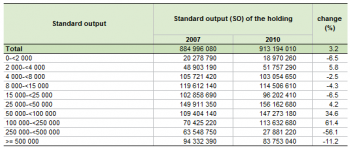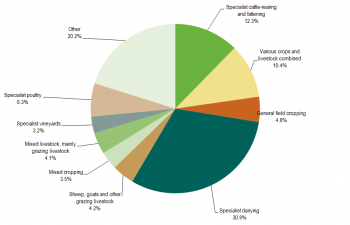Archive:Agricultural census in Slovenia
This article has been archived.
This article is part of a series of country-specific essays on the results of the European Union (EU) Farm structure survey (FSS). The FSS collects information on the structural characteristics of the agricultural holdings (land use, livestock and labour force) and is carried out by all European Union Member States every 10 years as an Agricultural census, with two or three additional, intermediate sample surveys carried out in-between. The Agricultural census 2010 was the second one to be fully harmonised with the EU regulation as well as the second one to be carried out in the independent Republic of Slovenia. The present analysis of the farm structure includes a comparison with the Agricultural census 2000, the first one to be carried out according to the EU requirements in Slovenia.

Source: Eurostat (ef_kvaareg) (ef_ov_kvaa) (demo_pjan) and FSS 2000 and 2010
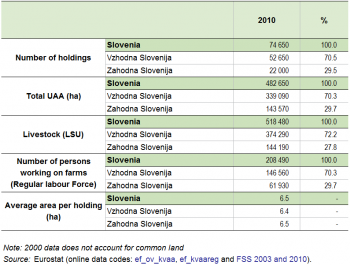
Special value: "-" not applicable
Source: Eurostat (ef_kvaareg) (ef_ov_kvaa) and FSS 2010

Source: Eurostat (ef_kvaareg) (ef_ov_kvaa)

Source: Eurostat (ef_kvftreg)
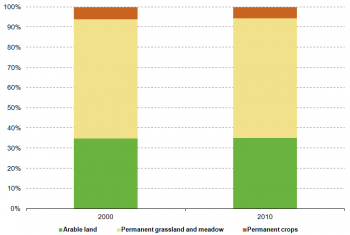
Source: Eurostat (ef_lu_ovcropaa) (ef_oluaareg)
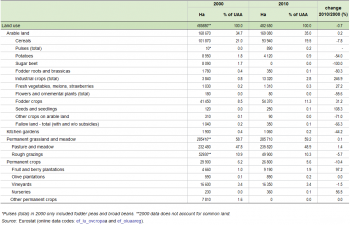
Special value: "-" not applicable
Source: Eurostat (ef_lu_ovcropaa) (ef_oluaareg)

Source: Eurostat (ef_mptenure)

Source: Source: Eurostat (ef_pmhouscatlaa)
Main statistical findings
Key indicators
According to the FSS 2010, there were 74 650 agricultural holdings in Slovenia (see Table 1). Compared to the Agricultural census 2000, this corresponds to a 13.7 % decrease and places Slovenia among the countries with the smallest number of farms within the EU-27. In absolute terms, about 12 000 farms ceased their activities within the inter-census decade.
On the contrary, the utilised agricultural area (UAA) in Slovenia remained stable over the 2000-2010 timeframe, posting a value of 482 650 ha in 2010, a figure which corresponded to 24 % of the whole territory of the country. In absolute terms, the agricultural area decreased by only about 3 200 hectares (-0.7 %) within the period under analysis, suggesting that the bigger holdings took over the agricultural land of the small ones that closed down. This tendency, also observed in many Member States throughout the EU, led to an increase of the average area per holding, which grew by 15.1 %, from 5.6 hectares per farm in 2000 to 6.5 ha per holding in 2010. Nonetheless, Slovenia was among the EU Member States with the lowest average area per farm in 2010. When analysing these figures, it must be kept in mind that common land was not included in the 2000 data set. Common land in Slovenia consists exclusively of rough grazing areas and covered an area of 22 790 ha in 2000. For further information, please consult Data sources and availability.
Within the inter-census period, the number of persons regularly working in agriculture dropped by 19.6 %. In absolute terms, 259 420 persons were regularly working on Slovenian farms in 2000 whereas only 208 490 were left in 2010. Nonetheless, in 2010 the agricultural labour force still represented 20.0 % of the Slovenian active population[1], one of the highest shares within the EU-27.
When looking at the livestock population – expressed in livestock units (LSU) – a decrease was observed in Slovenia. Within the decade under analysis values dropped by 15.2 %, from 611 100 LSU to 518 480 LSU, or 0.25 LSU per person, hence in 2010 Slovenia exhibited one of the smallest livestock populations in absolute terms among the EU Member States.
Regional key indicators
The analysis of regional data (exhibited in Table 2) provides further insight into the structure of Slovenian agriculture and highlights the leading role played by the territory of ‘Vzhodna Slovenija’. Indeed, for each of the key indicators studied (number of holdings, total UAA, livestock population and number of persons working on the farms), the eastern territory of ‘Vzhodna Slovenija’ accounted for about 70 % of the value of the whole country, while the western region of ‘Zahodna Slovenija’ was found to contribute the remaining 30 %.
According to the Agricultural census 2010, 52 650 farms were recorded within the border of ‘Vzhodna Slovenija’, a value which accounted for 71 % of the total population of agricultural holdings. The remaining 29 % of the Slovenian population of farms (22 000) was found to belong to the region of ‘Zahodna Slovenija’.
Data on agricultural area further confirm the skewed structure of the Slovenian agricultural sector, as 70 % of the UAA of the whole country was found to be located in ‘Vzhodna Slovenija’ (339 090 ha). Consequently, only 30 % of the Slovenian agricultural land (143 570 ha) was recorded within the territory of ‘Zahodna Slovenija’.
Percentages look very similar if the LSU and the number of persons working in agriculture are taken into account. 72 % of the livestock population was surveyed within the eastern territory of ‘Vzhodna Slovenija’ (374 290 LSU) in 2010, while only 144 190 LSU were recorded in the west of Slovenia – a value which corresponded to the remaining 28 %. Furthermore, within the eastern territory of Slovenia, 146 560 persons worked regularly in the agricultural sector (70 %), whereas the regular labour force recorded in ‘Zahodna Slovenija’ only reached 61 930 units, corresponding to 30 % of the whole regular agricultural labour force of Slovenia.
Agricultural holdings
In contrast with what was observed in most of the EU Member States, the majority of Slovenian farms proved to be rather small in 2010 (see Figure 1). According to the FSS 2010, 84 % of them (62 640) recorded less than 10 hectares of agricultural land and accounted for 47 % of the UAA of the entire country. The number of agricultural holdings with 10 to 19.9 hectares of UAA was also found to be remarkable (8 350): this class of holdings accounted for 11 % of the whole population of farms and was found to cover 23 % of the Slovenian agricultural land in 2010. On the contrary, farms with 20 hectares or more of UAA (3 470) recorded a marginal share (5 %) over the total population of agricultural holdings, but nevertheless accounted for 30 % of the country’s UAA.
In terms of the number of holdings, the biggest classes of farms recorded the largest growths, whereas farms with less than 10 hectares of UAA decreased, confirming that small holdings were taken up by bigger ones within the decade under analysis. In particular, the number of farms with 20 to 29.9 hectares of UAA grew by 60 % – from 1 260 in 2000 to 2 020 in 2010 – while farms with 30 to 49.9 hectares more than doubled their number reaching the value of 970 in 2010.
See detailed data at NUTS 2 level for 2010
Economic size of the farm
In 2010, the economic size of all the Slovenian agricultural holdings was EUR 913 million (see Table 3). This figure, which was calculated by summing up the standard output (SO) per hectare of crop and per head of livestock of the farms, was found to be among the smallest recorded within the EU-27 and ranked the country right below the EUR 1 000 million threshold. Compared to the FSS 2007 value (EUR 885 million), it represents an increase of 3.2 % mainly attributable to two classes of holdings: farms with an average monetary value of EUR 100 000 to EUR 249 999, which increased by 61.4 %, and those with an economic size of EUR 50 000 to EUR 99 999 (+ 34.6 %).
Small and medium sized farms proved to play an important role in the Slovenian agricultural structure: 42 % of the economic value of the country’s population of farms was the outcome of holdings with an average monetary value of less than EUR 25 000.
The skewed nature of the Slovenian agriculture structure is further confirmed by the economic analysis of the farms population. In 2010, 72 % of the country’s agricultural standard output (EUR 654 million) was found to be produced within the eastern territory of ‘Vzhodna Slovenija’, whereas the western region of ‘Zahodna Slovenija’ accounted for EUR 259 million, corresponding to 28 %.
See detailed data at NUTS 2 level for 2010 and 2007
Agricultural holding by main type of farming
According to the Agricultural census 2010, farms specialised in cattle-rearing and fattening were the most common in Slovenia, as they represented 19 % of the total population of holdings (see Figure 2). In terms of the main type of farming, the second most common type of farms were those specialised in various crops and livestock combined and the ones dedicated to general field cropping, as both accounted for 14 %. Agricultural holdings specialised in dairying recorded the only other relevant double digit share (10 %), whereas those dedicated to sheep, goats and other grazing livestock (9 %) fell just below the 10 % threshold.
The ranking appears different and suggests the existence of one main type of production if the economic size of the holdings is taken into account: agricultural holdings dedicated to dairying represented 31 % of the SO of all the Slovenian farms. Holdings dedicated to cattle-rearing and fattening recorded the second highest share, accounting for 12 % of the whole country’s standard output, while farms specialised in various crops and livestock combined accounted for the only other remarkable double digit percentage (11 %).
Holdings specialised in poultry show a particularly remarkable distribution: While they only represent a share of 0.3 % of all Slovenian holdings, they account for 6.3 % of the country’s total standard output.
See detailed data at NUTS 2 level for 2010
Land use
The utilised agricultural area (UAA) is the total area – taken up by arable land, permanent grassland and meadow, permanent crops and kitchen gardens – used by the holding, regardless of the type of tenure or whether it is used as a part of common land.
In Slovenia, arable land and permanent grassland and meadow are the main components of the UAA and their shares did not change much over the years (see Table 4).
According to the FSS 2010, permanent grassland and meadow covered 59.2 % of the Slovenian UAA, whereas arable land accounted for 35 %; permanent crops shared a marginal 5.6 %. Thus, the two main components together accounted for 94.2 % of the whole UAA, a value slightly higher than the one they recorded in 2000 (93.5 %).
See detailed data at NUTS 2 level for 2010
Arable land
In 2010, arable land was essentially taken up by cereals and fodder crops. In particular, cereals covered the widest portion – 93 940 hectares, corresponding to 19.5 % of the entire UAA – while 54 370 hectares of arable land were found to be dedicated to the production of fodder crops, a value which accounted for 11.3 % of the Slovenian UAA. In addition, industrial crops recorded a minor 2.8 % share over the total UAA, covering 13 320 hectares of arable land. It is remarkable that the production of sugar beets ceded completely, plummeting from 8 090 ha in 2000. This is a result of Slovenia giving up its quota for sugar beet production.
See detailed data at NUTS 2 level for 2010
Permanent grassland and meadow
Permanent grassland and meadow was found to be the main component of the Slovenian agricultural area and it accounted for about 60 % of the country’s UAA throughout the decade under analysis: in absolute terms it only moved from 285 410 ha in 2000 to 285 710 ha in 2010. Its composition did not change over the years, thus the land dedicated to pasture and meadow maintained its prominence indicating the value of 235 820 hectares in 2010, a figure which corresponded to 48.9 % of the Slovenian UAA.
On the other hand, the area of rough grazing slightly decreased within the time frame under analysis, from a 10.9 % share of the whole UAA (52 930 ha) to 10.3 % (49 900 ha).
See detailed data at NUTS 2 level for 2010
Livestock
Statistics on livestock use two different units of measurement: the number of heads (number of animals) and the livestock units (LSU), with the latter allowing comparison between different types.
As exhibited in Table 5, about half a million (518 480) LSU were recorded in Slovenia in 2010 – one of the smallest values surveyed among the EU Member States. This figure, which represents a 15 % drop compared to 2000, was found to include mainly cattle, pigs and poultry: together they accounted for 93 % of the whole Slovenian livestock. In particular, cattle accounted for 64 % of the country’s farm animals, pigs contributed to another 18 %, whereas poultry corresponded to 11 % of the Slovenian livestock in 2010.
Within the timeframe under analysis, pigs were the livestock that recorded the highest decrease (-37 %); in absolute terms, their number dropped from 146 050 LSU in 2000 to 92 340 LSU in 2010. Poultry numbers fell by one fourth and reached 58 690 LSU, while those of cattle dropped by only 8 %, leading to a value of 331 700 LSU in 2010.
Between 2000 and 2010, the Slovenian population increased by 3 % while the livestock decreased by about 15 %. As a result, the number of livestock per inhabitant dropped, from 0.31 in 2000 to 0.25 in 2010. Also, the number of holdings with livestock fell (-24 %): 77 480 farms with livestock were surveyed in 2000 whereas only 59 220 were left in 2010. Furthermore, the share of holdings with livestock among the population of farms dropped – from 90 % in 2000 to 79 % in 2010 – although it still represented one of the highest shares within the EU-27. In particular, remarkable drops were recorded for farms with 5 to 9 LSU (-33 %), while a relevant growth was recorded for holdings with 50 to 99 livestock units (53 %).
Most of the holdings with LSU (72 %) were found within the eastern territory of Slovenia, while ‘Zahodna Slovenija’ accounted for a minor 28 % in 2010. Percentages look the same if the total number of livestock is taken into account: 72 % of Slovenian farm animals (374 290 LSU) were recorded in ‘Vzhodna Slovenija’, while 28 % of them were surveyed within the western territory of Slovenia (144 190 LSU).
See detailed data at Nuts 2 level for 2010 and 2000
Labour force
As in most of the EU Member States, also in Slovenia the agricultural labour force dropped over the inter-census decade (-19.6 %): in particular, 259 420 persons were working in agricultural holdings in 2000 while only 208 490 were left in 2010 (see Table 6), which still is more than 10 % of the Slovenian population, a value among the highest within the EU-27. If the direct labour force is taken into account, in annual work units (AWU), the drop looks even sharper (-28.7 %), as the figure decreased from 107 530 AWU in 2000 to 76 650 AWU in 2010.
Also in terms of AWU, ‘Vzhodna Slovenija’ proved to be the most important production territory for the Slovenian agriculture, as 71 % of the total agricultural labour force directly employed in the holding worked within its borders in 2010 – Western Slovenia accounted for a minor 29 %.
As for the sole holders, the gender distinction was substantial, as about 3 out of 4 sole holders were found to be male in 2010. This distribution looked stable as figures did not change over the period under analysis.
See detailed data at NUTS 2 level on holders' age and gender for 2010 and 2000
See detailed data at NUTS 2 level on type of labour force for 2010 and 2000
Management practices
Type of tenure
In 2010, most of the Slovenian agricultural land (71.5 %) was found to belong to the farmers who actually worked on that land (see Table 7). On the other hand, about one fourth of the country’s UAA (129 170 ha) was farmed by tenants, while common land was marginal (1.7 %) and accounted for only 8 220 hectares.
Animal housing
Table 8 lists the number of places for cattle by type of housing. More than half of the places (55.8 %) are in stanchion tied stables with solid dung and manure, while 30.8 % of the places allow the animals to move freely.
In Slovenia, the total number of places (478 630) slightly exceeded the number of heads of cattle, suggesting the hosting capacity of the country was not fully met in 2010 and explaining why that percentage was more than 100. Furthermore, it must be noted that holdings could record more than one type of animal housing.
Other gainful activities
In 2010, there were 12 520 holdings in Slovenia with activities other than farm work, directly related to the holding and having an economic impact on the farm. These holdings represented 17 % of the Slovenian farm population – one of the highest percentages recorded among the EU Member States.
Information on other gainful activities was collected by eleven category types depending on their characteristics and each holding could register more than one activity.
In Slovenia, forestry work was by far the most common other gainful activity, since 9 080 farms recorded it as a source of extra income (see Table 9). Another important source of income was the processing of farm products, an activity which was performed by 2 390 holdings.
See detailed data at NUTS 2 level for 2000
Organic farming
Organic agriculture is an ecological production management system that promotes and enhances biodiversity, biological cycles, and soil biological activity. It is based on the minimal use of off-farm inputs and on the management practices that restore, maintain or enhance ecological harmony.
Both the number of holdings and the UAA under organic farming increased steadily over the last decade (see Table 10). On the reference day there were 1 860 holdings practising organic farming in Slovenia on a total area of 25 040 ha, or 5.2 % of the total Slovenian UAA.
See detailed data at Nuts 2 level for 2010, 2007, 2005
Data sources and availability
Methodological notes
The Agricultural Census 2010 was the second one fully harmonised with the European legislation to be carried out in Slovenia. In 1997, Slovenia conducted the first FSS as a pilot survey for the Agricultural Census 2000; hence, a definition of agricultural holding in line with the one presented in the EU legislation along with a comparable threshold was set up. Since then, Slovenia followed the EC programme for Farm Structure Surveys both in terms of the list of characteristics and the timetable, conducting sample surveys in 2003, 2005 and 2007. The Statistical Office of the Republic of Slovenia was the responsible body for conducting the Agricultural census 2010, although an external contractor was appointed to carry out the data collection.
Survey on agricultural production methods (SAPM)
In 2010 a unique survey was carried out together with the Agricultural census: the Survey on agricultural productions methods (SAPM). This survey collected data at regional level needed to establish agri-environmental indicators as indicated in COM final 508/2006 and to evaluate the greening of the Common agricultural policy.
Data were collected according to specifications listed in Annex V of regulation 1166/2008, namely data on tillage methods, soil conservation, landscape features, animal grazing, animal housing, manure application, manure storage and treatment facilities and irrigation.
In Slovenia, the SAPM was conducted as a sample survey together with the Agricultural census. A stratified sampling method and a random selection of units were employed to select 9 863 farms.
Reference period
The reference date was set to the 1st of June 2010. However, information on the labour force characteristics refers to the 12 months before this date, whereas data on the rural development measures were collected with reference to the 31st May 2007 – 1st June 2010 time frame.
Threshold for agricultural holdings
For both the FSS and the SAPM, the target population included all the agricultural holdings with at least one hectare of agricultural land. Holdings falling under this threshold, based on UAA but complying with a set of different physical thresholds related to the hectares of certain types of crops or heads of cattle, were also included in the target population of both surveys. Furthermore, all farms producing vegetables, herbs, strawberries, mushrooms, flowers or ornamental plants for commercial purpose were included in the census.
The thresholds were unchanged from the 2000 census.
Common land
Common land is the land that does not directly belong to any agricultural holding but on which common rights apply. It can consist of pasture, horticultural or other land. The treatment of the common land used by an agricultural holding might differ from country to country.
In Slovenia, common land is an area under shared farming or other modes and consists of permanent grassland and meadow used for rough grazing. Before 2010, data on common land were collected only for national needs and they were not sent to Eurostat; hence, they are not included in the 2000 dataset analysed throughout this article. The area of common land decreased considerably over the years, from 22 786 ha in 2000 to 8 220 ha in 2010. Accordingly, it covered 4.7 % of the Slovenian agricultural area in 2000, while in 2010 it only accounted for 1.7 % of it. Differences between 2010 and 2000 data on agricultural area might be slightly influenced by the exclusion of common land from the FSS 2000 dataset transmitted to Eurostat and analysed in the present article.
Geo-reference of the holding
In Slovenia, the statistical farm register was used to locate the agricultural holdings. The register is owned by the Ministry of Agriculture, Forestry and Food for administrative purposes and includes data on holders’ addresses and the location of the holdings.
Economic size
From FSS 2007 onward, the standard output (SO), a new classification of the economic size of the holding is used. The SO has replaced the standard gross margin (SGM) used before. Nonetheless, for comparability reasons, in FSS 2007 both classifications are available.
Other methodological issues
- Regional comparability between FSS 2000 and FSS 2010
- In Slovenia, the NUTS 2 classification – a hierarchical system for dividing up the territory of the EU for economic and statistical purposes – was not yet implemented in 2000. Therefore, regional data on the Agricultural census 2000 are not available in the Eurostat database and were not included in the present article.
Context
European Commission Rural development policy aims to improve competitiveness in agriculture and forestry, the environment and the countryside, as well as the quality of life in rural areas and to encourage the diversification of rural economies.
As agriculture has modernised and the importance of industry and services within the economy has increased, so agriculture has become much less important as a source of jobs. Consequently, increasing emphasis is placed on the role farmers can play in rural development, including forestry, biodiversity and the diversification of the rural economy, in order to create alternative jobs and provide environmental protection in rural areas.
The FSS continues to adapt in order to provide timely and relevant data to help analyse and follow these developments.
See also
- Agricultural census 2010
- All articles on Slovenia
- All farm structure articles by country (2007)
- Farm structure statistics
Further Eurostat information
Publications
- Agriculture, fishery and forestry statistics — Main results – 2010-11 - 2012 edition
- Farm Structure in Slovenia - 2007 - Statistics in focus 87/2008
- Farm Structure in Slovenia - 2005 - Statistics in focus 11/2006
Main tables
- Agriculture, see:
- Farm structure: historical data (1990-2007)(t_ef)
Database
- Agriculture, see:
- Farm structure (ef)
Dedicated section
Methodology / Metadata
- Farm structure (ESMS metadata file — ef_esms)
- [httphttp://ec.europa.eu/eurostat/documents/749240/749313/SI_NMR_FSS_2010.pdf/134625aa-acb7-43a0-92d5-f16c8913221f Methodological Report – FSS 2010 Slovenia]
- Methodological Report – FSS 2007 Slovenia
Source data for tables and figures (MS Excel)
Other information
- Regulation 1166/2008 of 19 November 2008 on farm structure surveys and the survey on agricultural production methods and repealing Council Regulation 571/88
- Regulation 1200/2009 of 30 November 2009 implementing Regulation 1166/2008 on farm structure surveys and the survey on agricultural production methods, as regards livestock unit coefficients and definitions of the characteristics
External links
Notes
- ↑ A value calculated over the active population in the 4th quarter 2010 of the EU Labour force survey (LFS) Population, activity and inactivity - quarterly data
